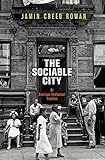The Sociable City : An American Intellectual Tradition / Jamin Creed Rowan.
Material type: TextSeries: The Arts and Intellectual Life in Modern AmericaPublisher: Philadelphia : University of Pennsylvania Press, [2017]Copyright date: ©2017Description: 1 online resource (208 p.) : 13 illusContent type:
TextSeries: The Arts and Intellectual Life in Modern AmericaPublisher: Philadelphia : University of Pennsylvania Press, [2017]Copyright date: ©2017Description: 1 online resource (208 p.) : 13 illusContent type: - 9780812249293
- 9780812294156
- 307.1/216097309034 23
- HT167
- online - DeGruyter
- Issued also in print.
| Item type | Current library | Call number | URL | Status | Notes | Barcode | |
|---|---|---|---|---|---|---|---|
 eBook
eBook
|
Biblioteca "Angelicum" Pont. Univ. S.Tommaso d'Aquino Nuvola online | online - DeGruyter (Browse shelf(Opens below)) | Online access | Not for loan (Accesso limitato) | Accesso per gli utenti autorizzati / Access for authorized users | (dgr)9780812294156 |
Frontmatter -- Contents -- Introduction. Finding Fellow-Feeling in the City -- Chapter 1. The Settlement Movement's Push for Public Sympathy -- Chapter 2. New Deal Urbanism and the Contraction of Sympathy -- Chapter 3. Literary Urbanists and the Interwar Development of Urban Sociability -- Chapter 4. The Ecology of Sociability in the Postwar City -- Chapter 5. Jane Jacobs and the Consolidation of Urban Sociability -- Conclusion. The Future of Urban Sociability -- Notes -- Index -- Acknowledgments
restricted access online access with authorization star
http://purl.org/coar/access_right/c_16ec
When celebrated landscape architect Frederick Law Olmsted despaired in 1870 that the "restraining and confining conditions" of the city compelled its inhabitants to "look closely upon others without sympathy," he was expressing what many in the United States had already been saying about the nascent urbanization that would continue to transform the nation's landscape: that the modern city dramatically changes the way individuals interact with and feel toward one another. An antiurbanist discourse would pervade American culture for years to come, echoing Olmsted's skeptical view of the emotional value of urban relationships. But as more and more people moved to the nation's cities, urbanists began to confront this pessimism about the ability of city dwellers to connect with one another.The Sociable City investigates the history of how American society has conceived of urban relationships and considers how these ideas have shaped the cities in which we live. As the city's physical and social landscapes evolved over the course of the late nineteenth and twentieth centuries, urban intellectuals developed new vocabularies, narratives, and representational forms to express the social and emotional value of a wide variety of interactions among city dwellers.Turning to source materials often overlooked by scholars of urban life-including memoirs, plays, novels, literary journalism, and museum exhibits-Jamin Creed Rowan unearths an expansive body of work dedicated to exploring and advocating the social configurations made possible by the city. His study aims to better understand why we have built and governed cities in the ways we have, and to imagine an urban future that will effectively preserve and facilitate the interpersonal associations and social networks that city dwellers need to live manageable, equitable, and fulfilling lives.
Issued also in print.
Mode of access: Internet via World Wide Web.
In English.
Description based on online resource; title from PDF title page (publisher's Web site, viewed 26. Aug 2020)


